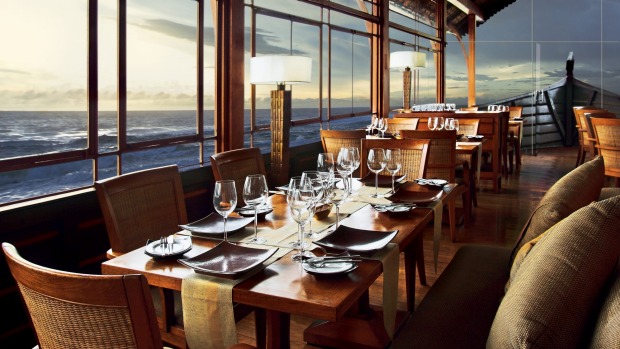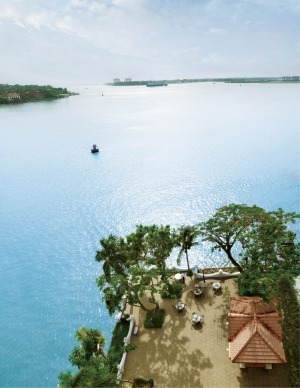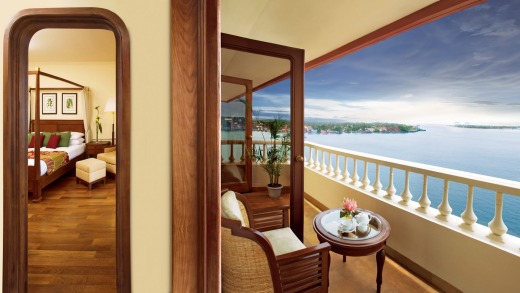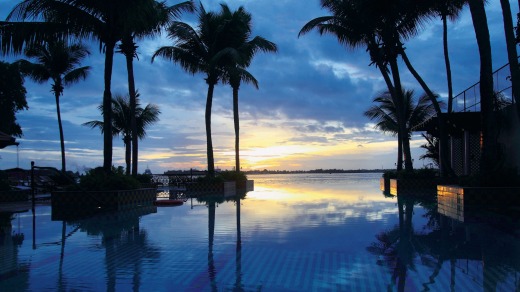
SIT at one end of the infinity pool at the Vivanta by Taj hotel in the southern Indian city of Kochi and you're rewarded with an uninterrupted view of the Vallarpadam International Container Transhipment Terminal on the other side of Vembanad Lake.
It's perhaps not the sexiest view in the world, but the stacked metal boxes and giant cranes are far enough away to be abstract, curiously artful and oddly relaxing. Swim up to the lip of the pool and you can watch the silent, bobbing dance of ferries, water taxis and fishing boats going about their business on the rest of this "lagoony harbour" – as Salman Rushdie called it in The Moor's Last Sigh, a novel which begins here in this (relatively) leisurely city.
Vivanta by Taj is an intriguing mix of old and new – the heritage wing was built in 1935 – and is incongruously situated right at the northern tip of Willingdon Island, a man-made island and still a working port.

It might seem an odd place to find a hotel but there's method in the madness. It's far enough away to be a true oasis after a day of dusty sightseeing around the bustle of old Fort Kochi, Mattancherry and the more modern Ernakulam but it's also still intimately connected to them by the public ferries which ply the waterways for the measliest of prices. It's four rupees, or about 10 cents, from Willingdon to Fort Kochi, for instance.
Kochi (aka Cochin) is a major port city of 600,000 people and also the international gateway to the increasingly popular waterways of Kerala State where 2000 or so thatched roof houseboats (kettuvallams) ply the labyrinthine chain of lagoons, canals, rivers, inlets and lakes southwards along the Malabar Coast – an Indian "bayou" of some 900 twisting kilometres.
You can hire a scooter, book a trip on the Kerala river system and fight off the gently insistent tuk-tuk drivers who offer to take you on a whistle stop tour for 100 rupees. Or 80 rupees. Or 45 rupees. Honestly, these guys will haggle with themselves if you let them.
Once a small fishing village, Kochi had become an important west coast spice trading centre when it was "discovered" in the final years of the 15th century by the explorer Vasco da Gama and occupied by the Portuguese Empire in 1503. It was later occupied by the Dutch and then the British until Indian independence in 1947.

All of which left parts of Kochi with a somewhat schizophrenic architectural legacy. No place more so than in Fort Kochi, which hugs the top of the peninsula that runs parallel with Willingdon Island and whose streets are a crumbling mishmash of colonial building styles, its waterways dotted with mouldering warehouses and the sad remains of grand old public buildings falling in on themselves.
Now, the first thing to understand about Fort Kochi is that there is no fort. Goats, yes. Fort, no. This comes as a bit of a shock, to be honest, and I blame the Dutch, who destroyed the Portuguese fort when they took over because, well, it was Portuguese.
Then along came the British who … well you get the idea.

One of the things that escaped all this rolling destruction is the line of romantic-looking, pre-colonial Chinese fishing nets along the waterfront. Purported to have been here since the early 14th century, the big square nets are dropped into the water by means of a simple pulley system using large rocks and are, if the number of sunscreen-drenched white people in big hats being disgorged from coaches is any indication, a popular tourist attraction. You might want to wander further on to the slightly scrubby Mahatma Gandhi beach, where locals use hand nets to catch their fish.
Another place that escaped wanton destruction is St Francis Church. Still there today just a block away from the waterfront next to a souvenir stall market and a gravelly soccer pitch on which barefoot boys kick the living daylights out of a football, it is famous for (a) being old and (b) once holding the body of Vasco da Gama, who died of malaria here in 1524 and is evoked in the name of every other tourism business nearby.
The narrow streets back from the church are awash with shaded cafes, hip boutique hotels, art galleries, clothes shops and cheap beer and wine "parlours". Here, within metres and minutes you can hire a scooter, book a trip on the Kerala river system and fight off the gently insistent tuk-tuk drivers who offer to take you on a whistle stop tour for 100 rupees. Or 80 rupees. Or 45 rupees. Honestly, these guys will haggle with themselves if you let them.
Further away, Fort Kochi morphs into Mattancherry, an area less touristy, more local, and well worth a meander if you have the time and inclination to get a little lost (as I did). With any luck you'll come across The Seagull Hotel (a bar/restaurant a few metres from the public ferry) and take some time to sit on the back deck with a Kingfisher beer while watching out for the dolphins that ply the waters and, if you're lucky, pop up later next to your ferry.
Back at the hotel that afternoon I take advantage of the small but perfectly formed gym and the pool before joining other guests at the free 5pm afternoon tea in the outdoor Dolphin's Point restaurant (grilled chicken and cucumber sandwiches, plum cake, mixed Bombay nuts, masala tea) followed by the nightly sunset cruise around the harbour.
On this, frenetic day turns to fancy-free evening as the boat putters past the Chinese nets, set ablaze by the setting sun, and the only sounds are the splash of the waves and the gentle whirr of cameras trying to capture the uncapturable.
vivantabytaj.com/malabar
AirAsia and Malaysia Airlines have daily flights from Sydney and Melbourne to Kochi (Cochin) via Kuala Lumpur. Singapore Airlines and Virgin fly via Singapore. See www.airasia.com; www.malaysiaairlines.com; www.singaporeair.com; www.virginaustralia.com
Tourist visas can now be obtained on arrival in India, though you'll need other documentation. Visit www.indianvisaonline.gov.in/visa/tvoa.html for more information. Advance visas can be obtained online see vfsglobal.com/india/australia/tourist.html but note that they are valid from the date of issue, not date of travel.
Smart Traveller (www.smartraveller.gov.au) warns tourists to exercise a high degree of caution in India due to "high threat of terrorist activity, civil unrest and crime, and the high rate of vehicle accidents". It adds: "Since February 12 this year there has been an increase in cases of influenza A(H1N1) in India. If you are travelling to India, discuss influenza vaccination requirements with your GP or a travel health professional before departing Australia."
Vivanta by Taj is at Willingdon Island, Cochin, Kerala. TEL +91 484 664 3000. Rooms range from "superior charm" rooms to "deluxe allure" suites and "premium temptation" suites. Room rates start from about A$168 a night. There is free wi-fi for up to two devices in all rooms.
An all-day diner and breakfast bar with views of the backwaters and gardens, featuring European, North Indian and Kerala cuisine.
Built to resemble a traditional kettuvallam rice boat this seafood restaurant has panoramic views of the harbour. Local sweet water fish, lobster, scampi, mussels, soft shelled crab, tiger prawns and snapper are on the menu.
Boasts that it's the only authentic Thai restaurant in Kerala. True or not, it's the place to go if you're sick of curry. Thai and Chinese dishes in a smart space just past the lobby.
Casual alfresco bar and grill area with water on two sides and romantic lanterns hanging in the trees at night. This where they have the free afternoon tea at 5pm. Open from October to March.